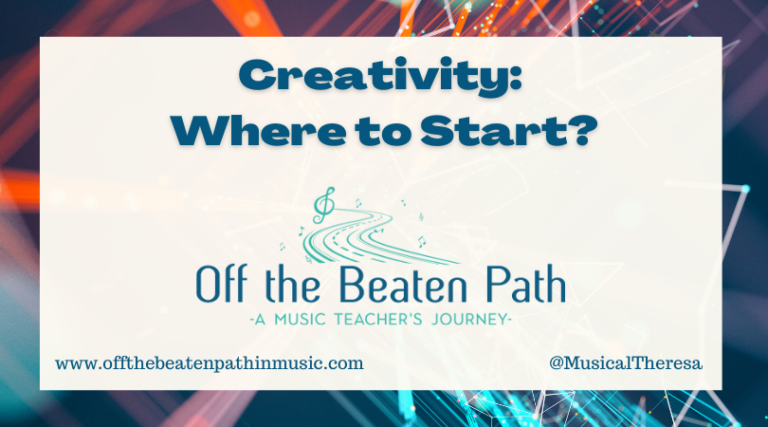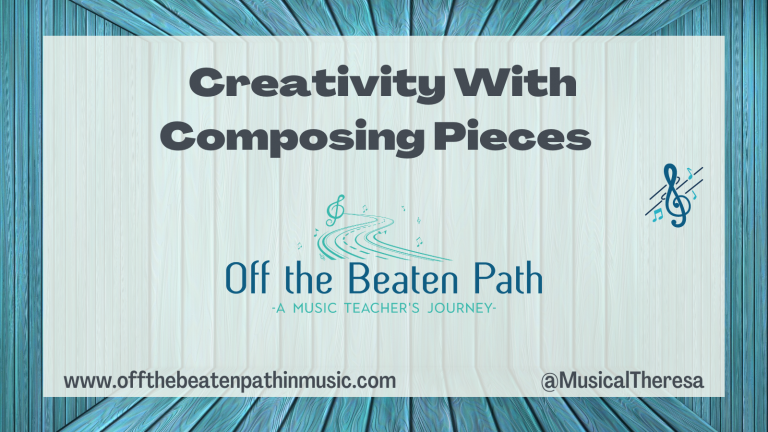Are We All Wired to Create?
One of the enjoyable tasks in this semester’s Listening and Creating class was the opportunity to read a book about creativity. We were offered several options to choose from, some related to music and music education, and others with a more broad look at creativity. I chose a book outside music education. I’ve read books like this in the past and thoroughly enjoyed them, and I felt like this was a great opportunity to dive into something I might not otherwise read. The book I chose was called Wired to Create: Unraveling the Mysteries of the Creative Mind * by Scott Barry Kaufman and Carolyn Gregoire. According to the book’s description, it explains “the 10 things highly creative people do differently.” I really enjoyed the book, and am excited to share some things I learned about the creative mind from reading it.

The Creative Mind is Messy
The book opens with some introductory information about creativity, including ideas of notable psychologists that I wrote about in What Does It Mean To Be Creative? Creativity is a process that involves the whole brain, both the default (imagination) network and the executive attention network. The imagination network comprises three components: personal meaning making, mental stimulation, and perspective taking. This network helps us do things like make meaning of experiences, think about the past and future, imagine other people’s perspectives, and reflect on mental and emotional states. I notice a lot of personal and empathetic awareness in the imagination network. The executive attention network helps us direct our attention, make plans, and focus the imagination. The creative mind is messy, and it’s the combination of the imagination network and the executive attention network that helps us to make the creative things happen.
Throughout the rest of the book, the authors share their research on “the 10 things highly creative people do differently.” They acknowledge some traits seem in opposition to each other, but reiterate that the creative mind is messy and full of paradoxes. I’ll give a brief description of the ten things here, but I definitely recommend checking out the book to learn more, or at the very least, read Carolyn Gregoire’s article that inspired the book, 18 Things Highly Creative People Do Differently.
Ten Things
- Imaginative Play: People who are creative make time for play and curiosity in their lives. Play also supports learning and helps reduce stress. It’s interesting to think about where we offer students the opportunity to play at school, especially as they get older.
- Passion: People who are creative will often fall in love with what they work on, which leads to their inspiration and passion. Children who fall in love with their dreams are more likely to have “personally meaningful and publicly recognized creative achievements”
- Daydreaming: Daydreaming is like the incubation stage mentioned in Wallas’s process (read more in What’s the Role of the Creative Process in Music?). It’s when the mind is quiet that our creative ideas can come to life. The authors suggest things like taking a shower or a hike to help calm the mind. “Find your own personal showerhead, a space where you let your mind roam free-whether it’s a walk near the ocean, a country drive, or in your reading nook at home.”
- Solitude: Similar to daydreaming, solitude allows us to find space within ourselves. It gives the mind space to reflect, make new connections, and find meaning. Similar to play, we can ask if solitude is something we provide time for in schools?
- Intuition: The authors describe intuition as a “sudden flash of insight.” While insight may feel like it comes out of nowhere, there is actually a lot going on in the brain leading up to it, including a “temporary shutdown of the visual cortex” that “turns the mind’s focus inward on the impending solution.”
- Openness to Experience: Highly creative people are often open to new experiences because we need these new and unusual experiences to help us think differently. It’s by disrupting the familiar that we find new ways of seeing things, which helps with creative thinking.
- Mindfulness: Mindfulness can feel in opposition to daydreaming because it implies paying attention as opposed to letting the mind wander. In fact, sometimes mindfulness can stifle creativity. The key is to reduce small, everyday distractions and focus on observational skills.
- Sensitivity: Highly creative people are often also quite sensitive. This is potentially because sensitive people will often observe, feel, and process more from their environment. Sensitivity can contribute positively to creative work and creative work can be beneficial to those who are sensitive. “Through creative work, sensitive people are able to channel their energy and emotions and create a sense of meaning out of their experiences.”
- Turning Adversity into Advantage: While not a requirement for creativity, often people who are highly creative have experienced adversity in their lives. In addition, creativity can be healing and used as a coping mechanism after a difficult experience. However, positive events can also help people express themselves creatively. The authors offer the following advice: “So if you’re looking for a creative boost, treat all of life’s meaningful moments – the good and the bad – as potential sources of inspiration and motivation. The best way to do that? Take risks and be prepared to fail.”
- Thinking Differently: According to the authors, thinking differently is one of the essential ingredients for creativity. Often, this difference in thought won’t initially be appreciated – most innovations that made a difference in society were initially met with resistance! In addition, there will probably be a lot of failures along the way. But, “in rejecting traditional ways of thinking, successful creative work defies standards and authority, causes trouble, and ultimately paves the way for real change.”
I can highly recommend Wired to Create to any music educators, to look not only at your own creativity but that of your students as well. For me, just reading through the list of ten things creative people do differently has made me examine my own creativity, noticing my own strengths and areas I think I can improve. Authors Kaufman and Gregoire believe that everyone is wired to create, and I have to agree. As teachers, we can help our students find the creativity that is within them. “When we embrace our own messiness – engaging with the world with our own unique imagination and artistry – we give others permission to do the same.”
Creativity is messy and worth being embraced.
Check out more in this series about creativity:
- What Does It Mean To Be Creative?
- What’s the Role of the Creative Process in Music?
- Is There Creativity in Convergent and Divergent Thinking?
*Please note, this post includes affiliate links, which means at no additional cost to you, I earn a small commission when readers purchase items through my links. This helps immensely with website hosting fees and similar expenses!






